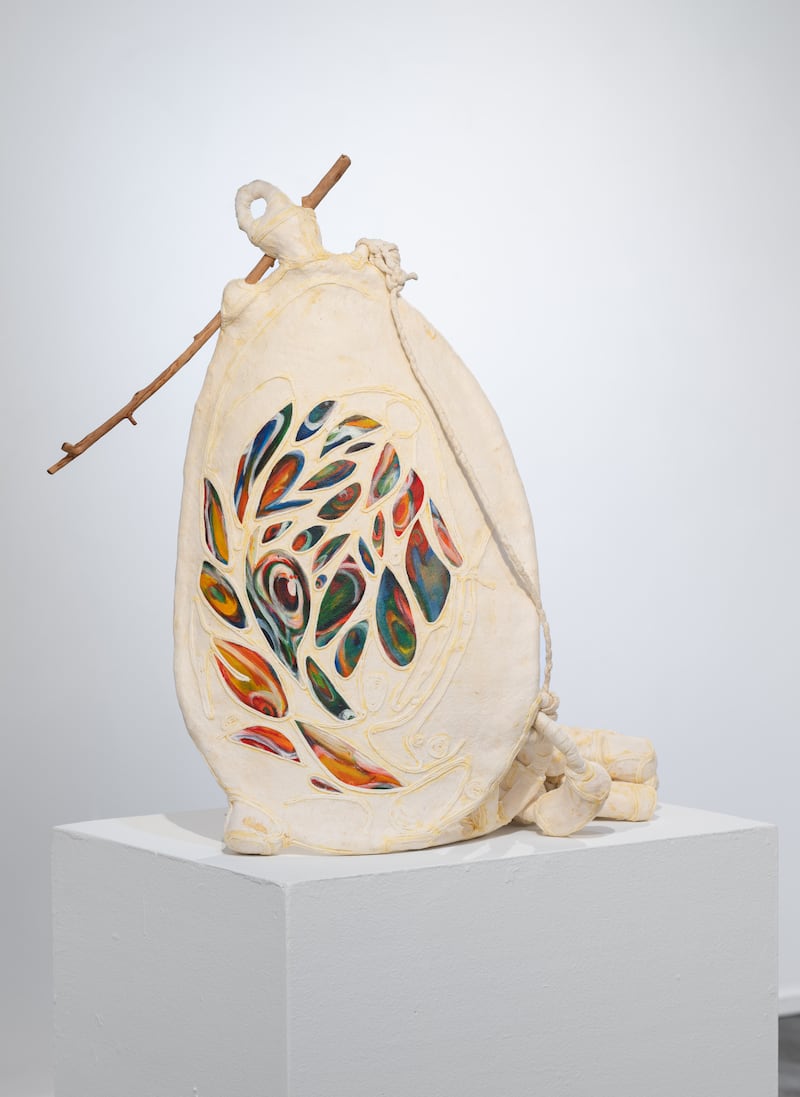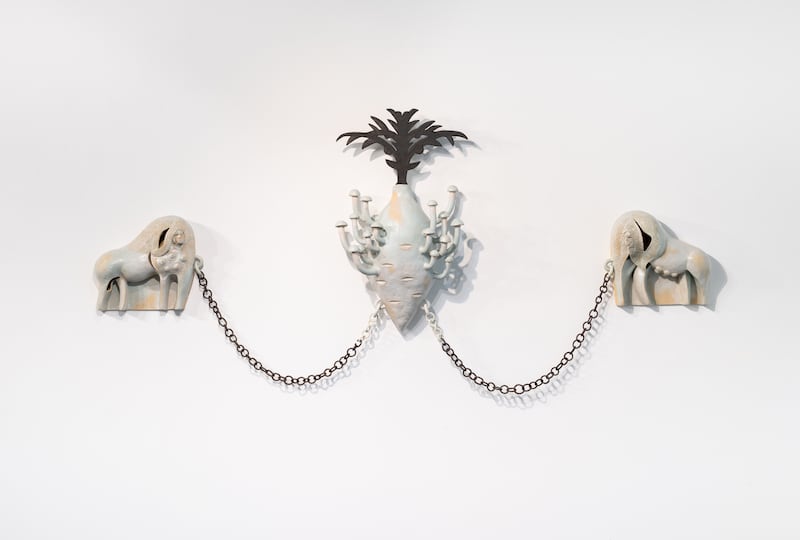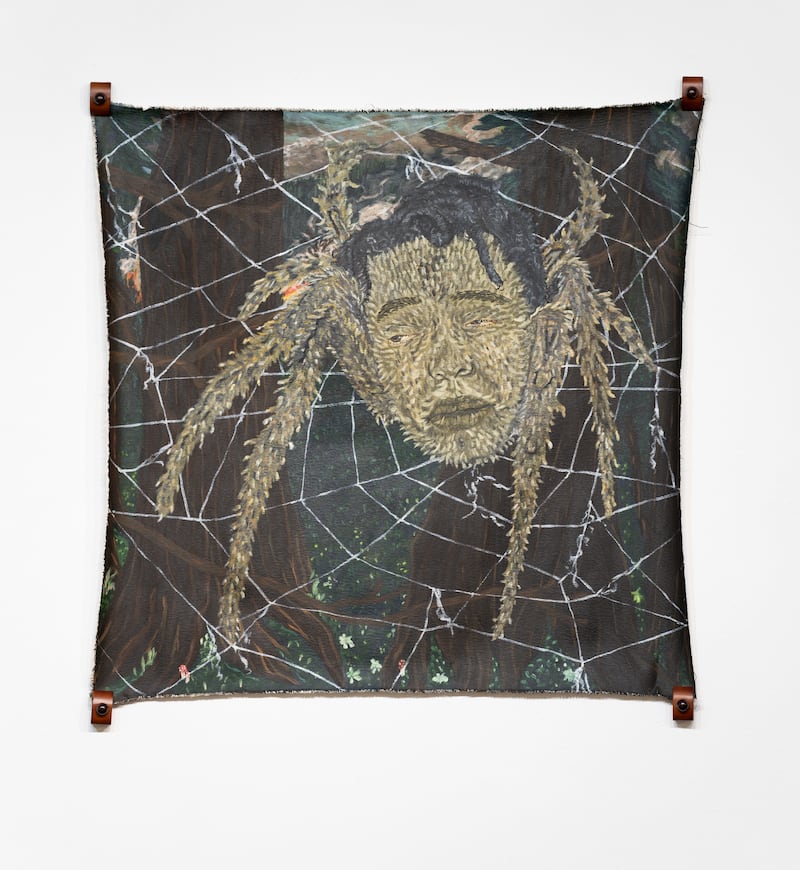Hyphae are the filaments which branch expansively to form fungi’s mycelial network. These networks run underground in a system that supports communication and nutrient sharing between plant life. They inspired curator Sharon Servilio to name Gallery 114′s current exhibition Hyphae, a show broaching the concept of ecological mysticism through nine artists’ work. Nestled in Portland’s Pearl District, Gallery 114 was founded in 1990 and prides itself on being “one of the oldest art collectives on the West Coast,” an ecology in its own right. Much like hyphae, the show’s individual works—on view through Saturday, Nov. 2—weave an energetic web, exploring mystic shapes and forms and transmitting messages from otherworldly realms.
Hyphae is anchored by two different sculptures by Japanese-born artist Kanetaka Ikeda, found near the respective centers of Gallery 114′s adjoining rooms. Ikeda’s works take inspiration from a vivid dream he had over three decades before, illustrating the universe embodied as a tree. One of the works, Parts of Cosmic Tree: Wings, looks like a large butterfly unfurling from a chrysalis with an insectlike form spewing a piece of wood from an orifice. The other, Parts of Cosmic Tree: Seeds #2, presents as a pale, oblong entity with ornate pods tethered to its form, and a stick born over its upper crest. In both pieces, referential shapes of this world give way to the greater lore, a story of both ecological and cosmological forces.

According to David Onri Anderson’s artist bio, “he believes in angels and will sometimes communicate with them in order to make paintings.” Perhaps this was the case for his Earth Angel City Demon, a painting composed of pigments from garden flowers as well as acrylic and graphite on raw canvas. It portrays a smiling being with a wide torso, where another more unsettling face comes into focus, eyes spiraling. Petra Szilagyi’s wood carving, Energetic topography, opens up in a similar fashion, revealing what looks like an abstract skeleton from the fibers of Australian red mallee timber.
Jessie Rose Vala’s wall hangings are dualistic in nature, finding uncanny balance through their strange forms. In Vala’s elaborate stoneware work Maria and Camille, two creatures hang opposite one another; they possess bodies of quadrupedal mammals, each with ambivalent humanoid faces, and are chained to a central vase that sprouts mushroomlike forms. In this way, the work suggests a story of the unwitting interdependence that threads between sentient life and ecology.

Carlie Kinto’s works on canvas echo Vala’s investigations of duality and balance. Using linework, mark-making and texture, her work “I am out with lanterns, looking for myself” presents a symmetrical abstract shape on canvas. Its hues of neon pink, orange and yellow beside sandy matte blue generate a luminescent aura fitting for the theme of personal discovery.
Catherine Sieck’s Three Shrines to Datura celebrates the highly poisonous datura flower. These “shrines” exist as wooden wall hangings with embossed datura flowers, created with copper and, in the case of the central shrine, oil paint. They seemingly reference religious iconography, honoring the precarity of life, its beauty and danger.

Francis Dot leans further into these themes with his 11-page collage Ploceidae, a contemporary illuminated text named for the scientific family of weaver birds. The pages describe ancient time travelers who move through portals between our world and other worlds. In this offering, Dot uses a pattern found on the Palestinian keffiyeh repeatedly as the visual for ploceidae’s “great net” made from the “fibers of spacetime,” gesturing to the interconnected fates of all life on earth.
Brian Zegeer fosters a sense of this interconnectedness on a microscale. The work takes up wall space with a paper background of grass fibers. Two TV screens embedded in the scene are wrapped in found materials—textile, tube, yarn. The TVs both loop a 3D animation, which unravels humanoid anatomy, drawing it in closer relationship to botanical kin.

Sadé DuBoise’s Sadé as Sad Spider, plays on the related theme of metamorphosis, presenting the hybridization of human and arachnid. DuBoise’s painting on canvas hangs dangling on a gallery wall much like a spider web. It depicts a version of her humanoid head with a melancholic expression, suspended on a spider web by eight hairy legs, becoming a metaphor for balancing numerous identities and states.
Taken together, the works of Hyphae reveal how ecology functions as a teacher and guide, fostering a sense of connection across material and psychic realms. Each of the artist’s contributions takes a different approach to transmission and transmutation of energy, drawing on ecological matter to critique spiritual indifference and disregard for interdependent systems that sustain life. The show drives home the truth that, like hyphae, we find our connection to one another through the earth, and without each filament, we would be lost.
SEE IT: Hyphae at Gallery 114, 1100 NW Glisan St., 503-243-3356, gallery114pdx.com. Noon–5 pm Thursday–Sunday.







